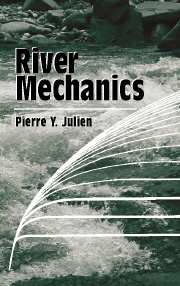Book contents
- Frontmatter
- Contents
- Preface
- Notation
- 1 Introduction to river mechanics
- 2 Physical properties and equations
- 3 River basins
- 4 Steady flow in rivers
- 5 Unsteady flow in rivers
- 6 River equilibrium
- 7 River dynamics
- 8 River stabilization
- 9 River engineering
- 10 Physical river models
- 11 Mathematical river models
- 12 Waves and tides in river estuaries
- Bibliography
- Index
6 - River equilibrium
Published online by Cambridge University Press: 05 June 2012
- Frontmatter
- Contents
- Preface
- Notation
- 1 Introduction to river mechanics
- 2 Physical properties and equations
- 3 River basins
- 4 Steady flow in rivers
- 5 Unsteady flow in rivers
- 6 River equilibrium
- 7 River dynamics
- 8 River stabilization
- 9 River engineering
- 10 Physical river models
- 11 Mathematical river models
- 12 Waves and tides in river estuaries
- Bibliography
- Index
Summary
In a strict sense, a channel is stable when all particles along the wetted perimeter are not moving. This implies that, without transport of bed material, a crosssectional geometry cannot change with time. The geometry of stable channels, also termed nonalluvial channels, depends on rock outcrops and artificial riprap and does not depend on sediment transport. Many rivers, however, flow in their own deposits, called alluvium, to form alluvial channels. Equilibrium of alluvial channels implies a balance between incoming and outgoing water discharge and sediment load. Poised and graded streams are synonyms describing equilibrium conditions. Whenever a balance is obtained between incoming and outgoing sediment discharges, the cross-sectional geometry may locally change as long as the deposition volume with a river reach is equal to the erosion volume. For instance, river bends may reach equilibrium condition between the rate of erosion on the outside bank and the rate of sedimentation on the point bar. In a broad sense, the cross-sectional geometry of a meandering channel is in equilibrium. However, lateral migration of the bend implies that the plan form geometry of the stream is not stable.
This chapter deals with stable and equilibrium river conditions. Section 6.1 details particle stability in a strict sense, and the concept of stable channel is used in Section 6.2 to define the ideal at-a-station cross-sectional geometry of a straight channel. Empirical regime relationships in Section 6.3 are followed by flow conditions in river bends in Section 6.4.
- Type
- Chapter
- Information
- River Mechanics , pp. 158 - 198Publisher: Cambridge University PressPrint publication year: 2002



